
 |
|
Peru - Stunning Geography; Rich History & Culture
Peru is defined by both its spectacular geography and its rich history. Between the tremendous Andean mountain range, and the rich heritage of its ancient civilizations and Spanish colonial past, Peru has something exciting to offer anyone interested in this exciting and vibrant country. From the Marvelous Andes to the Coastal Desert Western South America is defined by the backbone of mountains that run the length of the continent. 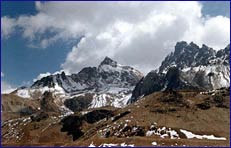 The majestic Andes tower high above the coastal plain. As the highest
tropical mountain chain in the world, the Andes have more than 30 peaks that
rise above 20,000 feet, with a majestic splendor rivaling that of the Himalayas.
As one wanders the ancient paths between the snow covered mountain passes, one
must sometimes pause to let a herd of llamas, mountain goats, or alpaca scramble by.
Besides the llamas and alpaca, which have both been domesticated, you will also find
the vicuña and the guanaco in the highland areas of Peru. The vicuña is said to have
the finest wool of any animal in the world, and the guanaco is a wild relative
of the llama and alpaca.
The majestic Andes tower high above the coastal plain. As the highest
tropical mountain chain in the world, the Andes have more than 30 peaks that
rise above 20,000 feet, with a majestic splendor rivaling that of the Himalayas.
As one wanders the ancient paths between the snow covered mountain passes, one
must sometimes pause to let a herd of llamas, mountain goats, or alpaca scramble by.
Besides the llamas and alpaca, which have both been domesticated, you will also find
the vicuña and the guanaco in the highland areas of Peru. The vicuña is said to have
the finest wool of any animal in the world, and the guanaco is a wild relative
of the llama and alpaca.
In southern Peru, one finds coastal deserts. These parched and desolate deserts have often been compared to the deserts of North Africa, and proved to be an obstacle to agriculture. But there were people who not only etched out a living here, but developed some rather advanced civilizations. Advanced Civilizations Peru's harsh mountain and desert environments hardly seem the place to have spawned civilizations that some have described as rivaling those of Egypt and Rome. Peru's most famous ancient civilization was the Inca Empire, which reached the height of its power in the thirteenth and fourteenth centuries. But the Incan Empire was not the only advanced ancient civilization of the Andean coast. It was simply the most recent. As far back as 3,000 B.C.E., early coastal communities began to move farther inland and learned to construct irrigation canals. They also invented pottery and simple weaving techniques. One of the early Andean cultures that grew from these groups was the Chavín culture, which acquired and inspired the art and architectural styles that spread throughout much of coastal and highland Peru. This culture brought innovations in textiles and metallurgy, and their weavings have been found with mummies unearthed by archeologists. The decline of the Chavín culture was followed by the emergence of regional cultures along the river 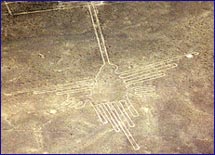 and highland valleys. These cultures lasted until about 600 A.D. and included the
Nazca and Moche cultures. The Nazca are known today for their famous Nazca images and
lines etched in the coastal deserts. The Nazca people etched the giant images by brushing
away surface soil and stones to reveal the lighter colored soil underneath. The
ancient images went unknown until the 20th century when they were observed by aircraft.
Their purpose has been theorized to be everything from paths leading to sacred sites to
visitors from space. Today it is believed that the most likely theory is that the lines form
part of an astronomical calendar.
and highland valleys. These cultures lasted until about 600 A.D. and included the
Nazca and Moche cultures. The Nazca are known today for their famous Nazca images and
lines etched in the coastal deserts. The Nazca people etched the giant images by brushing
away surface soil and stones to reveal the lighter colored soil underneath. The
ancient images went unknown until the 20th century when they were observed by aircraft.
Their purpose has been theorized to be everything from paths leading to sacred sites to
visitors from space. Today it is believed that the most likely theory is that the lines form
part of an astronomical calendar.
While the Nazca culture was predominant in southern Peru, The Moche culture flourished along the northern coast. The Moche built irrigation canals and aqueducts that cultivated fields for miles. They were famous for their ceramics, and they imported semi-precious stones from the present day areas of Chile and Argentina, and sea shells from the Gulf of Guayaquil in present day Ecuador. The Moche were the most skilled metal smiths in ancient Peru, and they perfected electrochemical plating techniques. The Inca Empire These cultures and others, some of whom have left no archeological traces, were dominated 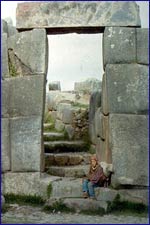 by the rise of the Inca Empire in the 1400's. The Peruvian Sierra was tamed by the Incas.
They taught their terraced system of agriculture and irrigation techniques to the
people they conquered, enabling large areas of steep yet fertile land to be cultivated.
Their agricultural terraces can still be seen about the country in such places as the
ancient Inca city of Machu Picchu. They also taught Inca stone architecture to the people
that they conquered.
by the rise of the Inca Empire in the 1400's. The Peruvian Sierra was tamed by the Incas.
They taught their terraced system of agriculture and irrigation techniques to the
people they conquered, enabling large areas of steep yet fertile land to be cultivated.
Their agricultural terraces can still be seen about the country in such places as the
ancient Inca city of Machu Picchu. They also taught Inca stone architecture to the people
that they conquered.
The Inca people, the Children of the Sun, assimilated the crafts and techniques of the conquered people, making them one of the most advanced and successful cultures in the world. 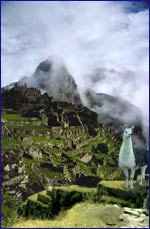 The irrigated deserts and terraced mountains were producing bountiful crops,
storehouses of food had eliminated hunger, and the Inca military might was legendary. These
were the people who ruled Peru and western South America when the Spanish Conquistadors
invaded Peru in the 1500's.
The irrigated deserts and terraced mountains were producing bountiful crops,
storehouses of food had eliminated hunger, and the Inca military might was legendary. These
were the people who ruled Peru and western South America when the Spanish Conquistadors
invaded Peru in the 1500's.
The Inca were shattered by this bloody Spanish Conquest. With their superior weapons, the Spanish Conquistadors seized control of the Inca world, ruthlessly stripping the nation of its glory and virtually enslaving its people. During the period of Spanish colonization of Peru, the Spaniards converted many of the native people to Catholicism, although for many, Christianity was simply a thin veneer over their traditional cults and beliefs. The ancient temples, tombs, and villages were pillaged for "booty": gold and silver that filled the coffers of the Spanish Crown. The Spanish ruled Peru until its independence in the early 19th century, and Peru has struggled for stability up until the present time. Today, almost half of Peru's 27 million people are of pure Indian origin, and many still speak the ancient Quecha language of the Incas. Handicrafts Peru's rich cultural history has been handed down to many of the present day people via their handicrafts. From weavers living high in the Andes, to the silversmiths of Lima, many of the crafts have changed little for centuries, while others have incorporated contemporary artistic ideas and design. Peru's local artists produce some of the richest and most unique handicrafts found anywhere. Peru has some of the finest silver found anywhere in the world. A higher grade than sterling, jewelry from Peru has a beautiful luster and delightful sparkle. |
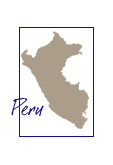
|
|||||||||||||||||||||||
Global Tradewinds Home
|
Customer Service
|
Contact Us
|
About Us © 2002-2008 Global Tradewinds, Inc. All rights reserved. |
|||||||||||||||||||||||||